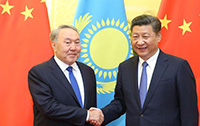Xi's APEC remarks herald better future of regional common development
(Xinhua) Updated: 2015-11-19 10:24Construction of FTAAP
With various new regional free trade arrangements cropping up, worries about fragmentation are on the increase.
In his speech, Xi urged relative parties to speed up the realization of the Free Trade Area of the Asia-Pacific (FTAAP) and strengthen the openness and inclusiveness of free trade arrangements to the greatest extent.
Recalling that APEC leaders made a historic step in 2014 in Beijing by launching FTAAP process, he called for concerted efforts to boost the openness of the Asia-Pacific economy and safeguard multilateral trade systems.
In order to avoid fragmentation, Liu Chenyang, director of the APEC research center of Nankai University, suggested that the Asia-Pacific economies need more coordination among the existing free trade arrangements and promotion of the construction of FTAAP.
Huang echoed Liu's comments, saying that FTAAP is a blessing to enterprises of all kinds in the region as they can operate and compete in a more fair and just framework.
The accelerated construction of FTAAP would be undoubtedly conducive to regional economic recovery, Huang added.
Wilson Lee Flores, columnist of local newspaper the Philippine Star, said FTAAP has good prospects because it is big in scale and comprehensive in scope.
"Many Asians look forward to China's dynamic leadership of FTAAP, and hope this plan could be realized as soon as possible despite some obstacles. FTAAP is more win-win and inclusive," Flores said.




